Lyons W.C. (ed.). Standard handbook of petroleum and natural gas engineering.2001- Volume 1
Подождите немного. Документ загружается.

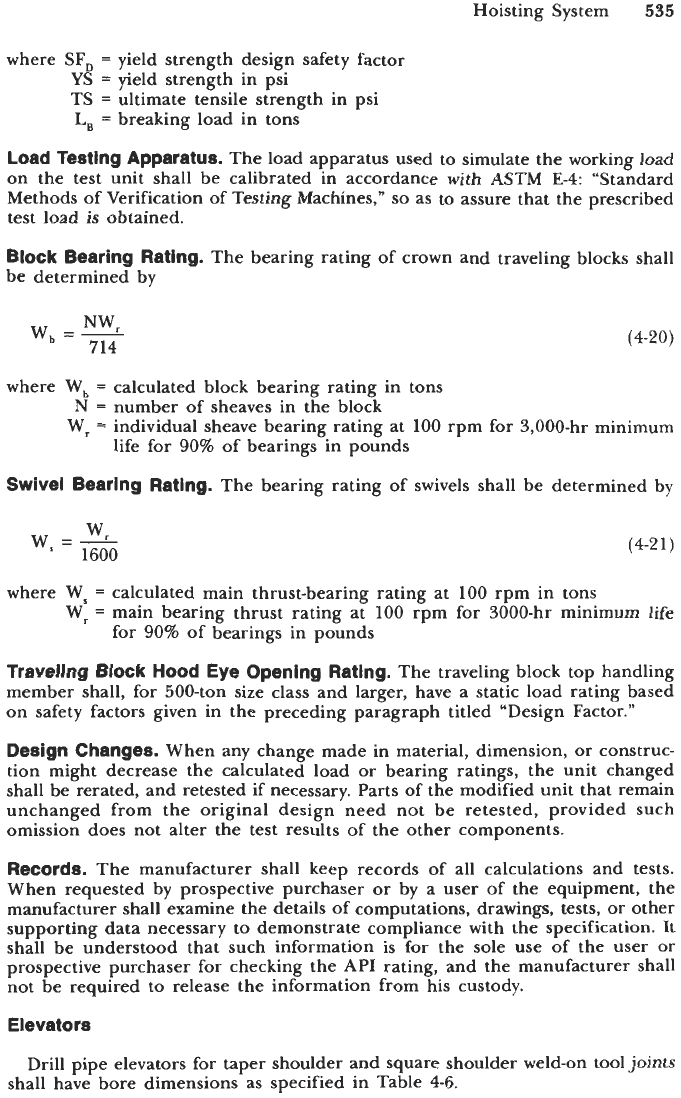
Hoisting System
535
where
SF,
=
yield strength design safety factor
YS
=
yield strength in psi
TS
=
ultimate tensile strength in psi
L,
=
breaking load in tons
toad Testing Apparatus.
The load apparatus used to simulate the working load
on the test unit shall be calibrated in accordance with ASTM
E-4:
“Standard
Methods of Verification of Testing Machines,”
so
as to assure that the prescribed
test load is obtained.
Block Bearing Rating.
The bearing rating
of
crown and traveling blocks shall
be determined by
NW,
w,
=-
714
(4-20)
where W,
=
calculated block bearing rating in tons
N
=
number of sheaves in the block
Wr
=
individual sheave bearing rating at
100
rpm for 3,000-hr minimum
life for
90%
of bearings in pounds
Swivel Bearing Rating.
The bearing rating of swivels shall be determined
by
w,
w,
=
-
1600
(4-2
1
)
where
Ws
=
calculated main thrust-bearing rating at
100
rpm in tons
Wr
=
main bearing thrust rating at
100
rpm for 3000-hr minimum life
Traveling Block Hood Eye Opening Rating.
The traveling block top handling
member shall,
for
500-ton size class and larger, have a static load rating based
on safety factors given in the preceding paragraph titled “Design Factor.”
Design Changes.
When any change made in material, dimension,
or
construc-
tion might decrease the calculated load
or
bearing ratings, the unit changed
shall be rerated,
and
retested if necessary. Parts
of
the modified unit that remain
unchanged from the original design need not be retested, provided such
omission does not alter the test results of the other components.
Records.
The manufacturer shall keep records of all calculations and tests.
When requested by prospective purchaser
or
by
a
user of the equipment, the
manufacturer shall examine
the
details of computations, drawings, tests,
or
other
supporting data necessary
to
demonstrate compliance with the specification. It
shall be understood that such information is for the sole use of the user
or
prospective purchaser for checking the
API
rating, and the manufacturer shall
not be required to release the information from his custody.
Elevators
for
90%
of bearings in pounds
Drill pipe elevators
for
taper shoulder and square shoulder weld-on tool joints
shall have bore dimensions as specified in Table
4-6.
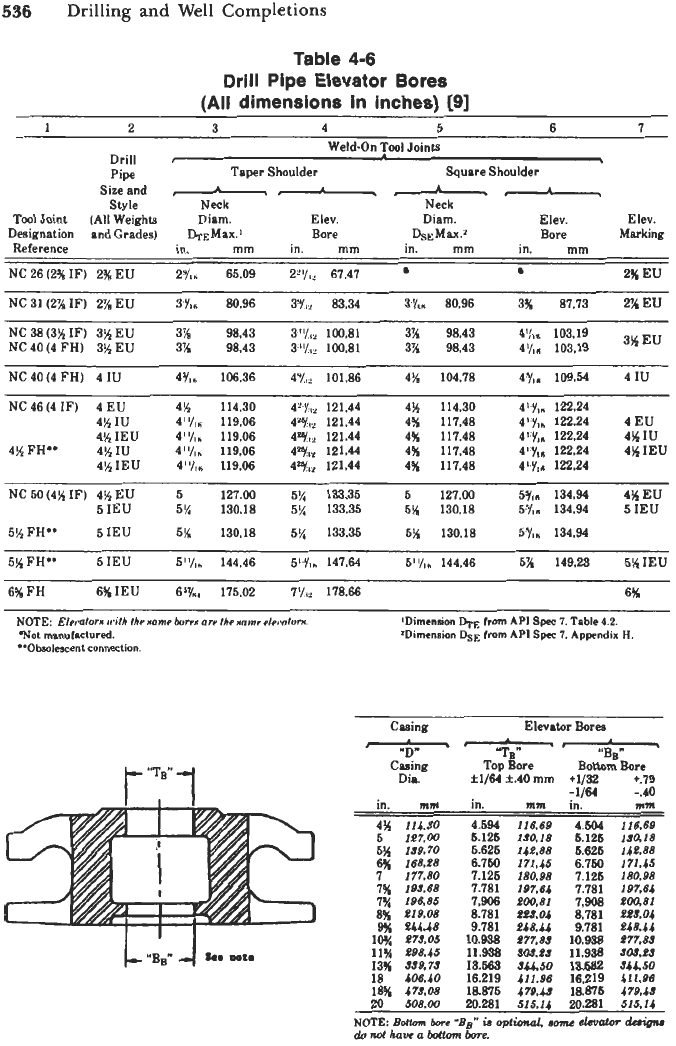
536
Drilling
and
Well
Completions
Table
4-6
Drill Pipe Elevator Bores
(All
dimensions in inches)
[9]
1
2
3
4
5
6
7
Weld-On
Tool
Joints
Drill
I
.
Pipe
Taper
Shoulder
Square Shoulder
Sizeand
,-.
.-
1
,-,
Style
Neck
Neck
Tool
Joint
(All
Weights Diam. Elev. Diam. Elev. Elev.
Designation and Grades)
t+&hX.'
Bore Ds~Max.' Bore Marking
Reference in.
mm
in.
mm
in.
mm
in.
mm
NC26(2XIF) 2XEU
2Ylw
65.09
2VS2
67.47
2%
EU
NC38(3%IF) 3KEU
3%
98.43
3"//,2
100.81 3% 98-43 4%H 103.19
NC 40(4 FH) 3KEU 3% 98.43 3'Yt!
100.81
3% 98.43
4YIH
103.19
3KEU
NC 40(4 FH)
4
IU
4Ylti
10636
4Y/v
101.86
4%
104.78
~YIR
109.54 4 Iu
NC
46 (4 IF) 4 EU 4% 114,30
4?Y,>
121.44 4% 114.30
4'Xn
122.24
4%
IU
4"/,,
119.06
4yYt, 121.44
4% 117.48
4IYlti 122.24 4
EU
4sIEU
4'YIn
119.06
4Yll
121.44
4% 117.48
4'Y,a
122.24
4WIU
4XIEU
4"fta
119.06
4Vt2
121.44
4% 117.48
4'Rn
122.24
4% FH**
4%
IU 4'YIb 119,06 474, 121.44
4%
117.48 4'Yln 122.24 4WIEU
NC50(4%IF) 4KEU
5
127.00
5%
133.35
5
127.00 5Yle 134.94 4HEU
5IEU 5% 130.18 5% 133.35
5%
130.18 5Y1. 134.94 51EU
5%FH** LIEU 5% 130,18 5% 133.35 5% 130.18 5Y,. 134.94
5!4FH** 51EU 5"/lh 144.46 5'Y,6 141,64 5'Y,, 144.46
6%
149.23 5KIEU
6% FH 6%IEU
65rl,,
175.02
7Y,,
178,66
6%
NOTE
Elrmlorn
with
thr
mme
(urn
aw
the
mme
drrntonr
Wot
manufactured.
**Obsolescent
conmedian.
~~-
'Dimension
DI.E
from
API
Spec
7.
Table
4.2.
'Dimension
&E
from
API
Spec
7.
Appendix
H.
Casing Elevator Bores
'
"D"
*
.
"TB"
-
'
"BE"
'
Cvling TopBore
BottomBore
Dia
ill64
f.40mm +1/32
+.79
4/64
-A0
in.
mm
in.
mm
in.
mm
IU
114.30
4.594
116,69
4.504
116.69
5
197.00
5.125
150.18
5.125
lSal8
5%
189.70
5.625
ILP.88
5.625
14P.88
6%
168.98
6.750
171.45
6.750
171.45
7
177.80
7.125
180.98
7.125
180,98
7%
196.85
7,906
900.81
7.908
PW.81
8%
919.08
8.781
428.04
8.181
PP9.04
9!4
944.48
9.781
948.U
9.781
Pb8.44
10%
975.05
10.938
f77.89
10.938
977.85
11%
998.45
11.938
805.49
11.938
3OS.29
13%
339.78
13.563
JU.50
13.502
84/50
18
406.40
16.219
411.96
16,219
411.96
20
SO8.W
20.281
515.14
20.281
515.14
NOTE:
Botrorn
borr
"BB*'
id
optional
gome
clcvdor
d&m
do
not
haw
a
both
bore.
1%
iga.6~
7.781
~64
7.781
197.64
18%
479m
iaw5
479.4s
iam
479.49
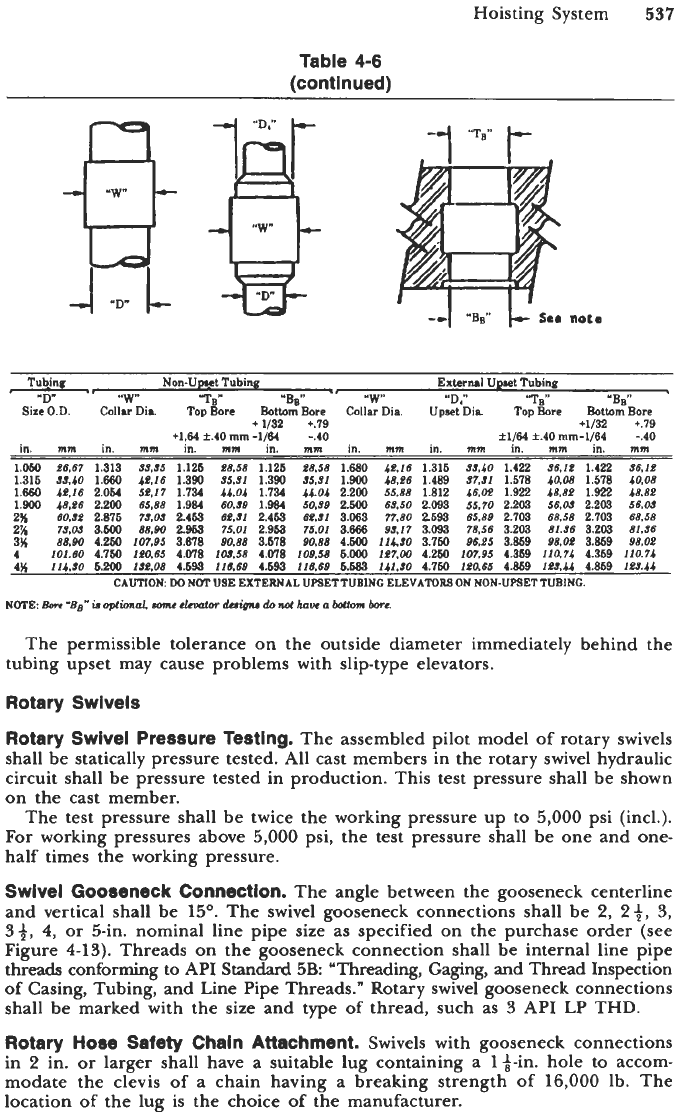
Hoisting System
537
Table
4-6
(continued)
Tubing
Non-Umt Tubing External
Upaet
Tubing
"TB"
"Bg"
.'
"W
"D."
'TB"
"BB"
"W"
'
'D"
'
Size O.D. Collar Din. Top Bore
Bottom
Bore
Collar Din.
Upset
Dia
Top
Bore
Bottom
Bore
+
1/32 +.I9 +1/32
+.I9
+1p 2.40
mm
-1/64
40
*1!64 f.40 mm-1(64 -.40
in.
mm
in.
mm
in.
mm
in.
mm
in.
mm
in.
mm
in.
mm
in.
mm
1.050
86.67
1.313
33.85
1.126
28.58
1.126
48.58
1.680
42.16
1.316
35.40
1.422
36.12
1.41
36.12
1.316
33.10
1.660
b2.16
1.390
35.31
1.390
85.31
1.900
43.26
1.489
37.31
1.678
40,08
1.578
40.08
1.660
&?,I6
2.064
54.17
1.734
bb.01
1.731
1b.04
2.200
55.88
1.812
16.02
1.9'22
b8,84
1.922
48.82
1.900
18.46
2.200
65.88
1.984
60.39
1.984
50.39
2.500
63.50
2.093
55.70
2.203
56.03
2.209
56.03
2%
60.32
2.876
73.08
2.463
62.31
2,463
68.31
S.063
77.80
2693
65.89
2.703
68.58
2.703
68.58
75.03
3.500
88.90
2.965
75.01
2.963
75.01
3.666
93.17
3.093
78,56
3.203
81.36
3.203
81.36
2'
88.90
4.260
107,95
3.678
90.88
3.678
90.88
4.500
llb.30
3.760
96.25
3.859
98.02
3.869
98,OP
:%
101.60
4.760
120.65
4.078
1W,58
4.078
109.58
6.OOO
127.00
4.260
101.95
4.369
110.74
4.369
110.7b
4%
111.30
5.200
134.08
4.693
118.69
4.693
116.69
6.683
IbI.30
4.750
180965
4.859
I23.4b
4.869
129.4.4
CAUTION
DO
NOTUSE EXTERNAL UPSETTUBING ELEVATOFSON NON-UPSETTUBING.
NOTE:Bm"lf~"i.opCioldmnne~~dowthawo~~
The permissible tolerance on the outside diameter immediately behind the
tubing upset may cause problems with slip-type elevators.
Rotary Swivels
Rotary Swivel Pressure Testing.
The assembled pilot model
of
rotary swivels
shall be statically pressure tested. All cast members in the rotary swivel hydraulic
circuit shall be pressure tested in production. This test pressure shall be shown
on the cast member.
The test pressure shall be twice the working pressure up to
5,000
psi (incl.).
For
working pressures above 5,000 psi, the test pressure shall be one and one-
half times the working pressure.
Swivel Gooseneck Connection.
The angle between the gooseneck centerline
and vertical shall be 15'. The swivel gooseneck connections shall be
2,
2+,
3,
33,
4,
or
sin. nominal line pipe size as specified on the purchase order (see
Figure
4-13).
Threads on the gooseneck connection shall be internal line pipe
threads conforming to API
Standard
5B
"Threading, Gaging, and Thread Inspection
of
Casing, Tubing, and Line Pipe Threads." Rotary swivel gooseneck connections
shall be marked with the size and type of thread, such as
3
API
LP
THD.
Rotary
Hose
Safety
Chaln
Attachment.
Swivels with gooseneck connections
in
2
in.
or
larger shall have a suitable lug containing a 13411. hole to accom-
modate the clevis
of
a chain having a breaking strength
of
16,000
lb. The
location of the lug is the choice
of
the manufacturer.
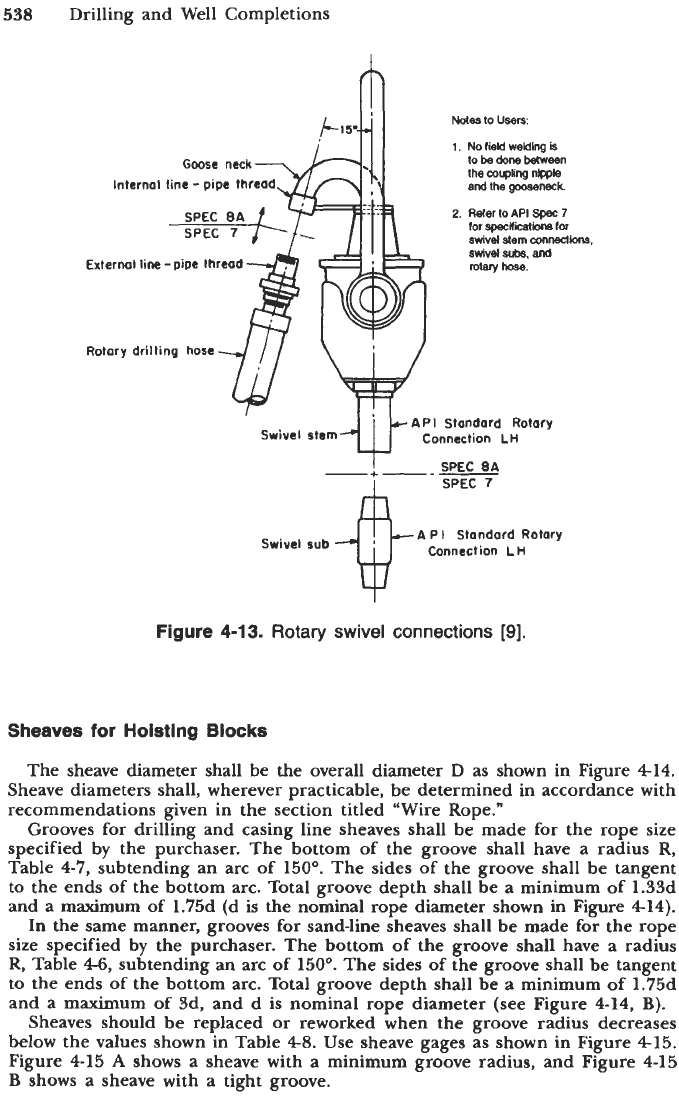
538
Drilling and Well Completions
lnternol line
-
External line
-pipe
Rotary drilling hose
Notes
io
users:
1.
Nofieldweldlngls
to
be
done
belwwn
the
ooupling
nrpple
and
the
gooseneck
2.
WertoAPlSpec7
swivel
&em
connections,
syhvel
subs.
and
mlary
hose.
tor
specficatii
for
API Standard Rotary
Connection
LH
-+---
SPEC EA
SPEC
7
Swivel
stem
A PI Standard Rotary
Connection
LH
#
Swivel
sub
Figure
4-13.
Rotary
swivel
connections
[9].
Sheaves
for
Hoisting
Blocks
The sheave diameter shall be the overall diameter
D
as shown in Figure 414.
Sheave diameters shall, wherever practicable, be determined in accordance with
recommendations given in the section titled “Wire Rope.”
Grooves for drilling and casing line sheaves shall be made for the rope size
specified by the purchaser. The bottom of the groove shall have a radius R,
Table
47,
subtending an arc of 150’. The sides
of
the groove shall be tangent
to the ends of the bottom arc. Total groove depth shall be a minimum of 1.33d
and a maximum of 1.75d (d
is
the nominal
rope
diameter shown in Figure 414).
In the same manner, grooves for sand-line sheaves shall be made for the rope
size specified by the purchaser. The bottom
of
the groove shall have a radius
R, Table
4-6,
subtending
an
arc of 150O. The sides of the groove shall be tangent
to
the ends of the bottom arc.
Total
groove depth shall be a minimum of 1.75d
and a maximum of Sd, and d is nominal rope diameter (see Figure 4-14,
B).
Sheaves should be replaced or reworked when the groove radius decreases
below the values shown in Table 4-8. Use sheave gages as shown in Figure 415.
Figure
415
A
shows a sheave with a minimum groove radius, and Figure 4-15
B
shows
a
sheave with a tight groove.
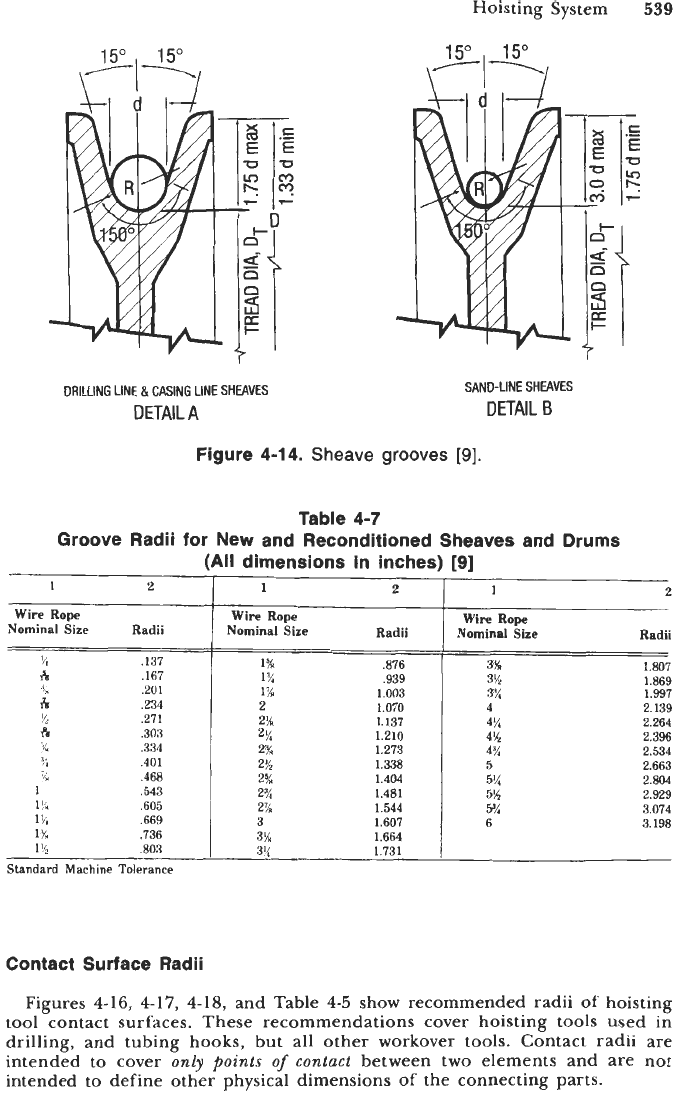
Hoisting System
539
2
1
Wire Rope
Nominal Size Radii
'4
.137
?a
,167
,201
6
234
h
271
ps
,303
i:
.334
.401
.468
1
,543
1
k
,605
1%
.669
1%
,736
1
%
,803
I,
15" 15"
\-I-/
1 2
1
2
Wirp Rope
Wire Rope
Nominal Size Radii Nominal Size Radii
1%
.E76
3%
1.807
1
'%
,939
3%
1.869
1% 1.003
3%
1.997
2
1.070
4
2.139
2%
1.210
4%
2.396
2%
1.273
4:x
2.534
2%
1.338
5 2.663
2% 1.404 5% 2.804
2%
1.481
5%
2.929
2%
1.137 4% 2.264
2%
1.544
5%
3.074
3
1.607
6
3.198
3% 1.664
3
1711
15"
15"
\-I?/
DRILLING
LINE
&
CASING LINE
SHEAVES
DETAIL A
SAND-LINE
SHEAVES
DETAIL
0
Figure
4-14.
Sheave grooves
[9].
Standard Machine Tolerance
Contact Surface Radii
Figures
4-16,
4-17,
4-18,
and Table
4-5
show recommended radii
of
hoisting
tool contact surfaces. These recommendations cover hoisting tools used in
drilling, and tubing hooks, but all other workover tools. Contact radii are
intended
to
cover
only points
of
contact
between two elements and are not
intended
to
define other physical dimensions
of
the connecting parts.
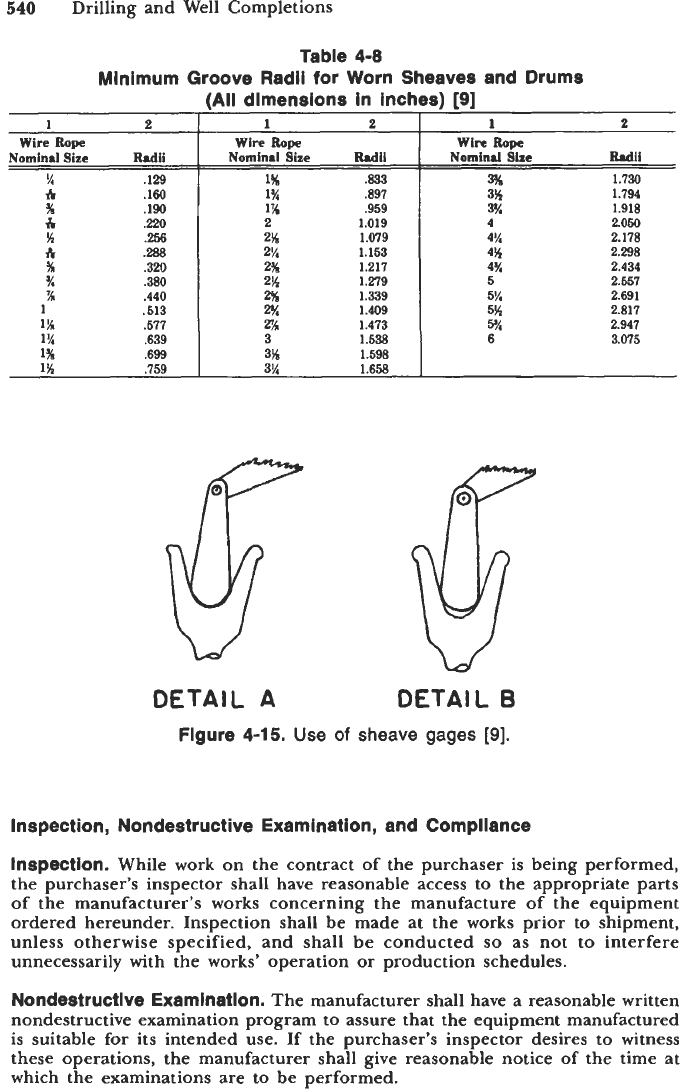
540
Drilling and Well Completions
Wire
Rope
Nominal Size Radii
%
,129
A!
.160
%
.190
B
.EO
Ih
256
B
.!?a
sk
,320
?4
.380
H
.440
1
.513
1% .577
1%
,639
1% ,699
1%
.I59
Table
4-8
Minimum Groove Radii for Worn Sheaves and Drums
(All
dimensions in inches)
191
Wire
Rope
wire
Rope
Nominal
Size
Radii
Nominal
Size
Radii
1% .833
3%
1.730
1%
297
3%
1.794
1% .959
3%
1.918
2
1.019
4
2050
2%
1.079
4%
2.178
2%
1.153 4%
2.298
216
1.217
4%
2.434
2%
1.279 5 2.557
2%
1.339 5% 2.691
-a
1.409
5%
2.817
a
1.473
5%
2.947
3 1.538 6 3.075
3% 1.598
3% 1.658
DETAIL
A
DETAIL
6
Figure
4-15.
Use
of
sheave gages
[9].
Inspection, Nondestructive Examination, and Compliance
Inspection.
While work on the contract of the purchaser is being performed,
the purchaser’s inspector shall have reasonable access to the appropriate parts
of the manufacturer’s works concerning the manufacture of the equipment
ordered hereunder. Inspection shall be made at the works prior to shipment,
unless otherwise specified, and shall be conducted
so
as not to interfere
unnecessarily with the works’ operation or production schedules.
Nondestructive Examination.
The manufacturer shall have a reasonable written
nondestructive examination program to assure that the equipment manufactured
is suitable for its intended use. If the purchaser’s inspector desires to witness
these operations, the manufacturer shall give reasonable notice
of
the time at
which the examinations are to be performed.
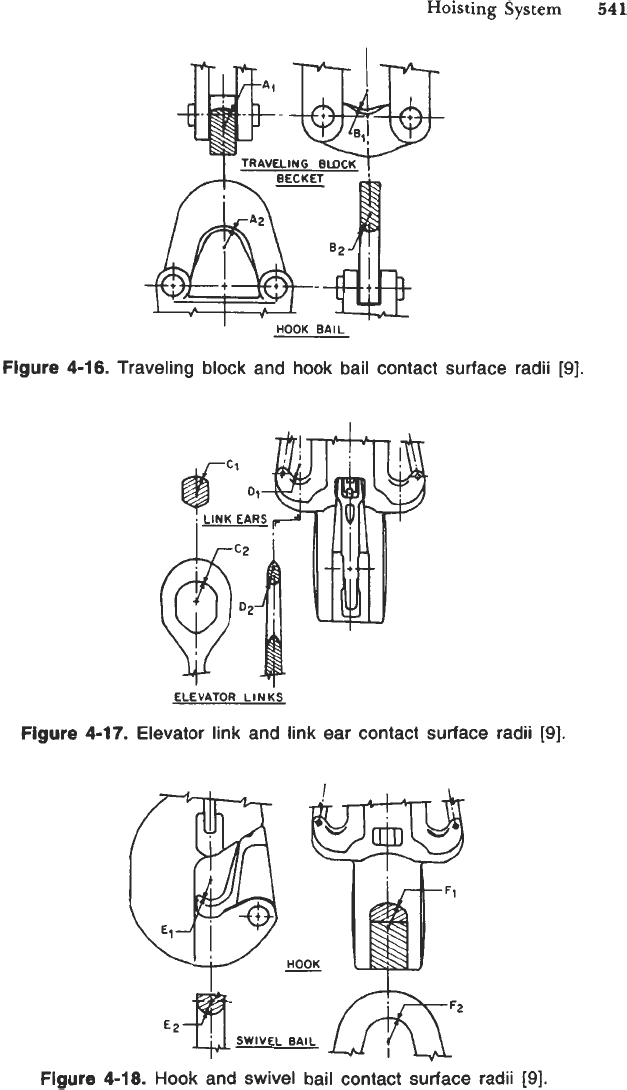
Hoisting
System
541
Figure
4-16.
Traveling block and
hook
bail contact surface radii
[9].
ELEVATOR
LINKS
Figure
4-17.
Elevator link and link ear contact surface radii
[9].
Figure
4-18.
Hook and swivel bail contact surface radii
[9].
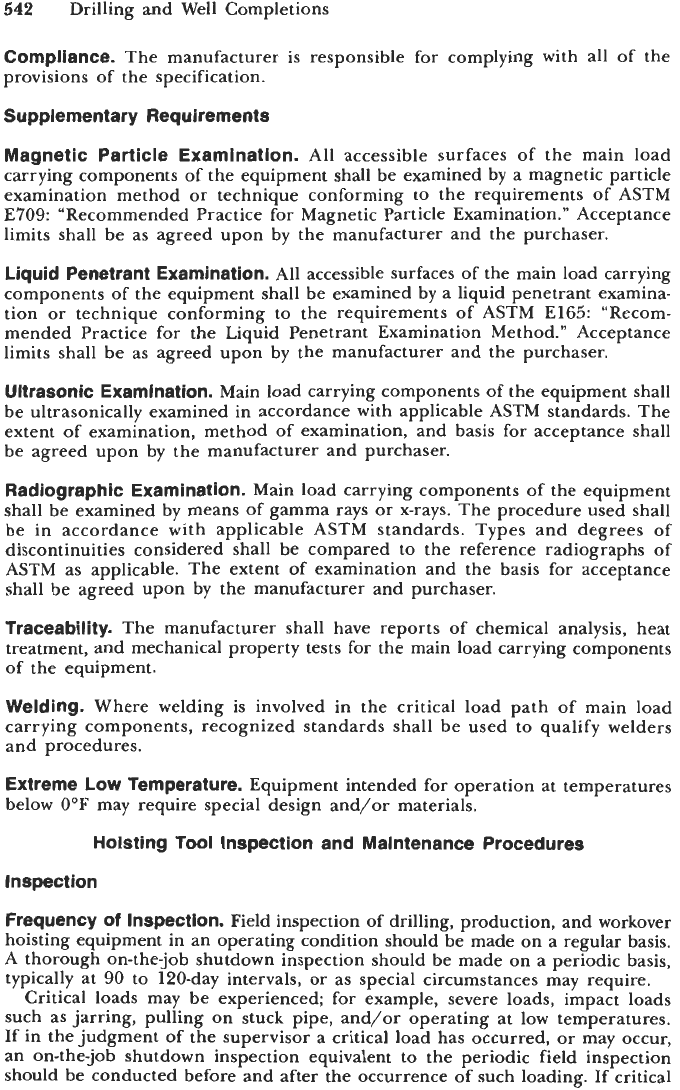
542
Drilling and Well Completions
Compliance.
The manufacturer is responsible for complying with all of the
provisions of the specification.
Supplementary Requirements
Magnetic Particle Examination.
All accessible surfaces
of
the main load
carrying components of the equipment shall be examined by a magnetic particle
examination method or technique conforming to the requirements
of
ASTM
E709:
“Recommended Practice for Magnetic Particle Examination.” Acceptance
limits shall be as agreed upon by the manufacturer and the purchaser.
Liquid Penetrant Examination.
All
accessible surfaces of the main load carrying
components of the equipment shall be examined by a liquid penetrant examina-
tion or technique conforming to the requirements
of
ASTM E165: “Recom-
mended Practice for the Liquid Penetrant Examination Method.” Acceptance
limits shall be as agreed upon by the manufacturer and the purchaser.
Ultrasonic Examination.
Main load carrying components
of
the equipment shall
be ultrasonically examined in accordance with applicable ASTM standards. The
extent
of
examination, method of examination, and basis for acceptance shall
be agreed upon by the manufacturer and purchaser.
Radiographic Examination.
Main load carrying components
of
the equipment
shall be examined by means of gamma rays or x-rays. The procedure used shall
be in accordance with applicable
ASTM
standards. Types and degrees of
discontinuities considered shall be compared to the reference radiographs of
ASTM as applicable. The extent of examination and the basis for acceptance
shall be agreed upon by the manufacturer and purchaser.
Traceability.
The manufacturer shall have reports
of
chemical analysis, heat
treatment, and mechanical property tests for the main load carrying components
of the equipment.
Welding.
Where welding is involved in the critical load path of main load
carrying components, recognized standards shall be used to qualify welders
and procedures.
Extreme LOW Temperature.
Equipment intended for operation at temperatures
below
0°F
may require special design and/or materials.
Hoisting Tool Inspection and Maintenance Procedures
Inspection
Frequency
of
Inspection.
Field inspection of drilling, production, and workover
hoisting equipment in an operating condition should be made on a regular basis.
A
thorough on-the-job shutdown inspection should be made on a periodic basis,
typically at
90
to 120-day intervals, or as special circumstances may require.
Critical loads may be experienced; for example, severe loads, impact loads
such as jarring, pulling on stuck pipe, and/or operating at low temperatures.
If in the judgment of the supervisor
a
critical load has occurred, or may occur,
an on-the-job shutdown inspection equivalent to the periodic field inspection
should be conducted before and after the occurrence of such loading. If critical
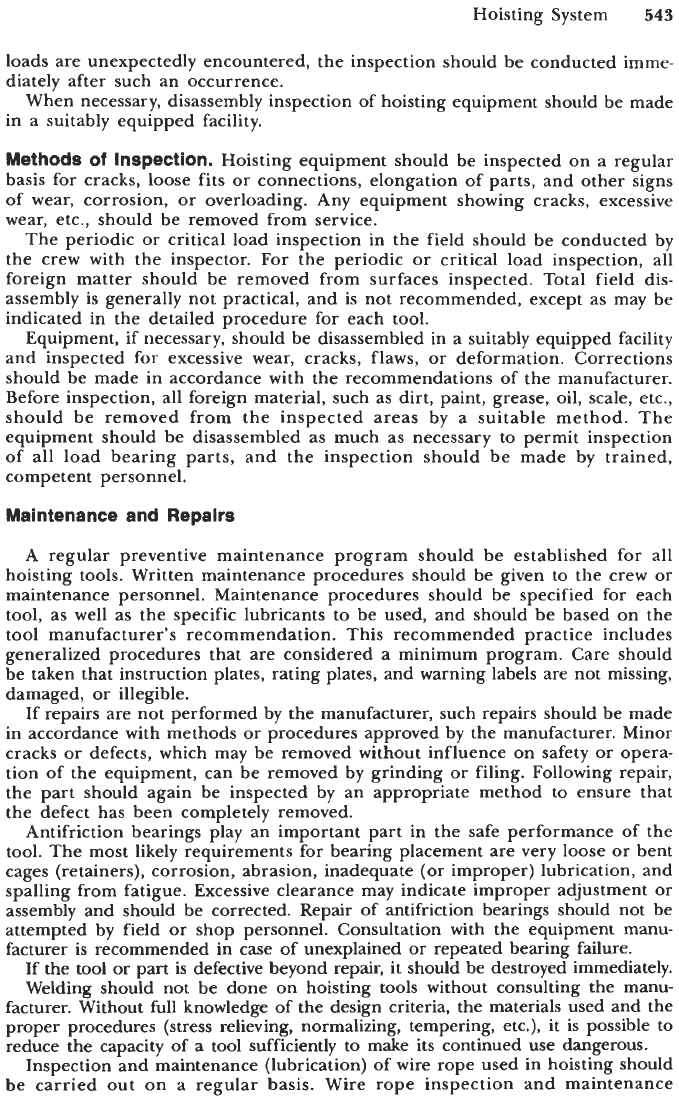
Hoisting System
543
loads are unexpectedly encountered, the inspection should be conducted imme-
diately after such an occurrence.
When necessary, disassembly inspection of hoisting equipment should be made
in a suitably equipped facility.
Methods
of
Inspection.
Hoisting equipment should be inspected on a regular
basis for cracks, loose fits or connections, elongation of parts, and other signs
of wear, corrosion, or overloading. Any equipment showing cracks, excessive
wear, etc., should be removed from service.
The periodic or critical load inspection in the field should be conducted by
the crew with the inspector. For the periodic or critical load inspection, all
foreign matter should be removed from surfaces inspected. Total field dis-
assembly is generally not practical, and is not recommended, except as may be
indicated in the detailed procedure for each tool.
Equipment, if necessary, should be disassembled in a suitably equipped facility
and inspected for excessive wear, cracks, flaws, or deformation. Corrections
should be made in accordance with the recommendations of the manufacturer.
Before inspection, all foreign material, such as dirt, paint, grease, oil, scale, etc.,
should be removed from the inspected areas by a suitable method. The
equipment should be disassembled as much as necessary to permit inspection
of all load bearing parts, and the inspection should be made by trained,
competent personnel.
Maintenance and Repairs
A
regular preventive maintenance program should be established for all
hoisting tools. Written maintenance procedures should be given to the crew
or
maintenance personnel. Maintenance procedures should be specified for each
tool, as well as the specific lubricants to be used, and should be based on the
tool manufacturer’s recommendation. This recommended practice includes
generalized procedures that are considered a minimum program. Care should
be taken that instruction plates, rating plates, and warning labels are not missing,
damaged, or illegible.
If
repairs are not performed by the manufacturer, such repairs should be made
in accordance with methods or procedures approved by the manufacturer. Minor
cracks or defects, which may be removed without influence on safety or opera-
tion
of
the equipment, can be removed by grinding or filing. Following repair,
the part should again be inspected by an appropriate method to ensure that
the defect has been completely removed.
Antifriction bearings play an important part in the safe performance of the
tool. The most likely requirements for bearing placement are very loose or bent
cages (retainers), corrosion, abrasion, inadequate (or improper) lubrication, and
spalling from fatigue. Excessive clearance may indicate improper adjustment or
assembly and should be corrected. Repair of antifriction bearings should not be
attempted by field or shop personnel. Consultation with the equipment manu-
facturer is recommended in case of unexplained or repeated bearing failure.
If the
tool
or part is defective beyond repair, it should
be
destroyed immediately.
Welding should not be done
on
hoisting tools without consulting the manu-
facturer. Without full knowledge of the design criteria, the materials used and the
proper procedures (stress relieving, normalizing, tempering, etc.), it is possible to
reduce the capacity
of
a
tool sufficiently to make its continued use dangerous.
Inspection and maintenance (lubrication) of wire rope used in hoisting should
be carried out on a regular basis. Wire rope inspection and maintenance
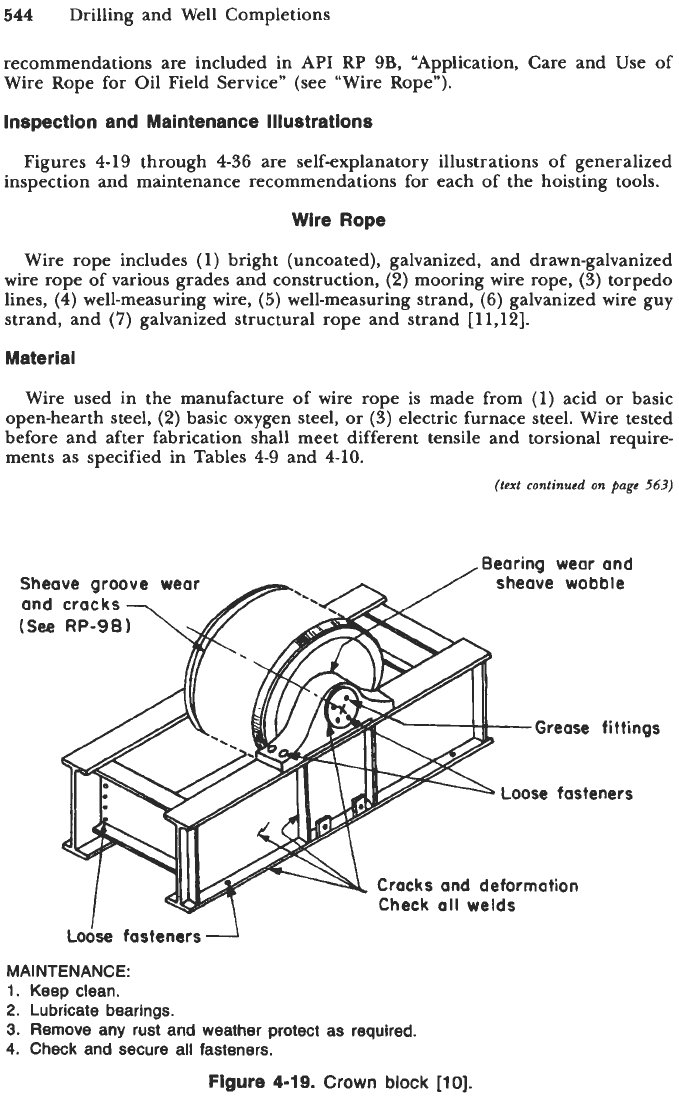
544
Drilling
and
Well Completions
recommendations are included in
API
RP
9B,
”Application, Care
and
Use of
Wire Rope for Oil Field Service” (see “Wire Rope”).
Inspection and Maintenance illustrations
inspection and maintenance recommendations for each of the hoisting tools.
Wire Rope
Wire rope includes
(
1)
bright (uncoated), galvanized, and drawn-galvanized
wire rope of various grades and construction,
(2)
mooring wire rope,
(3)
torpedo
lines,
(4)
well-measuring wire,
(5)
well-measuring strand,
(6)
galvanized wire guy
strand, and
(7)
galvanized structural rope and strand
[11,12].
Material
Figures
4-19
through
4-36
are self-explanatory illustrations of generalized
Wire used in the manufacture of wire rope is made from
(1)
acid
or
basic
open-hearth steel,
(2)
basic oxygen steel,
or
(3)
electric furnace steel. Wire tested
before and after fabrication shall meet different tensile and torsional require-
ments as specified in Tables
4-9
and
4-10.
(text
continued
on
page
563)
Bearing
wear
and
sheave wobble
Grease fittings
Loose
fasteners
Cracks and deformation
Check all welds
Loose
I
fasteners
-1
MAINTENANCE:
1.
Keep
clean.
2.
Lubricate bearings.
3.
Remove any
rust
and weather protect as required.
4.
Check
and secure all fasteners.
Figure
4-1
9.
Crown
block
[lo].
